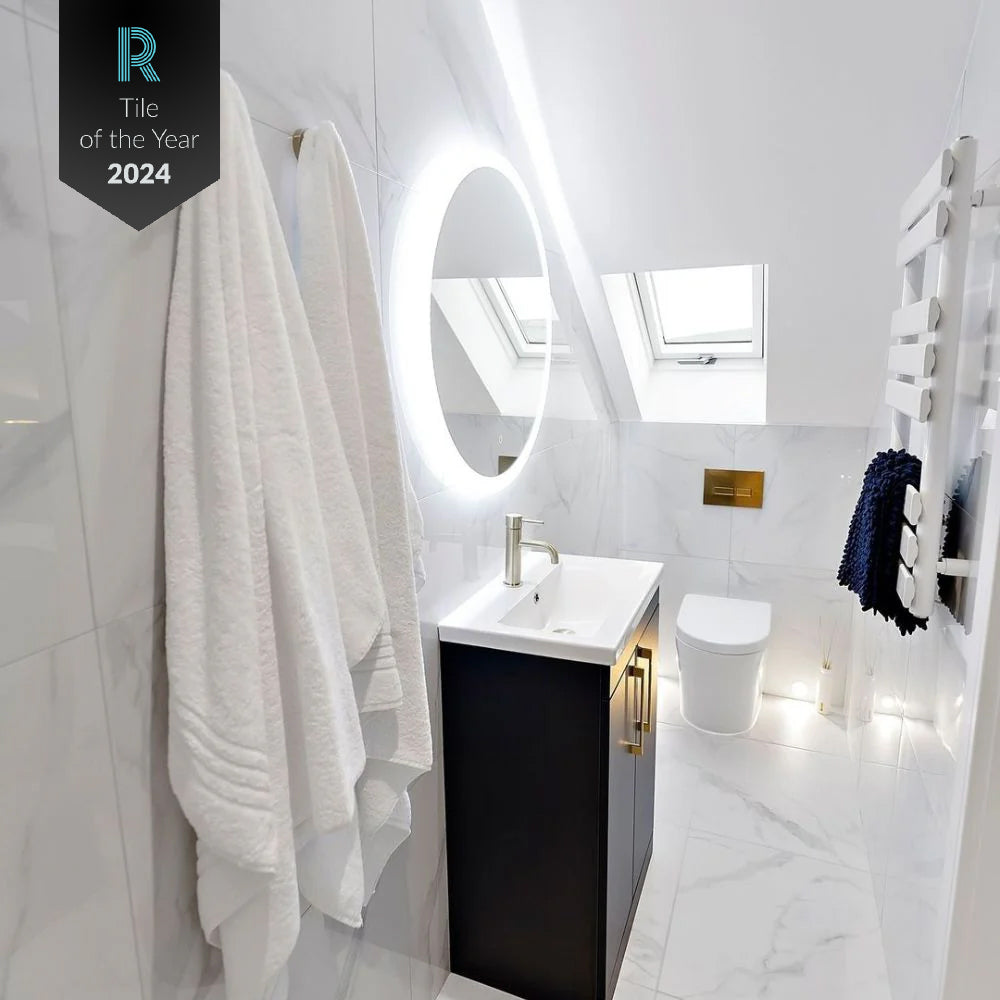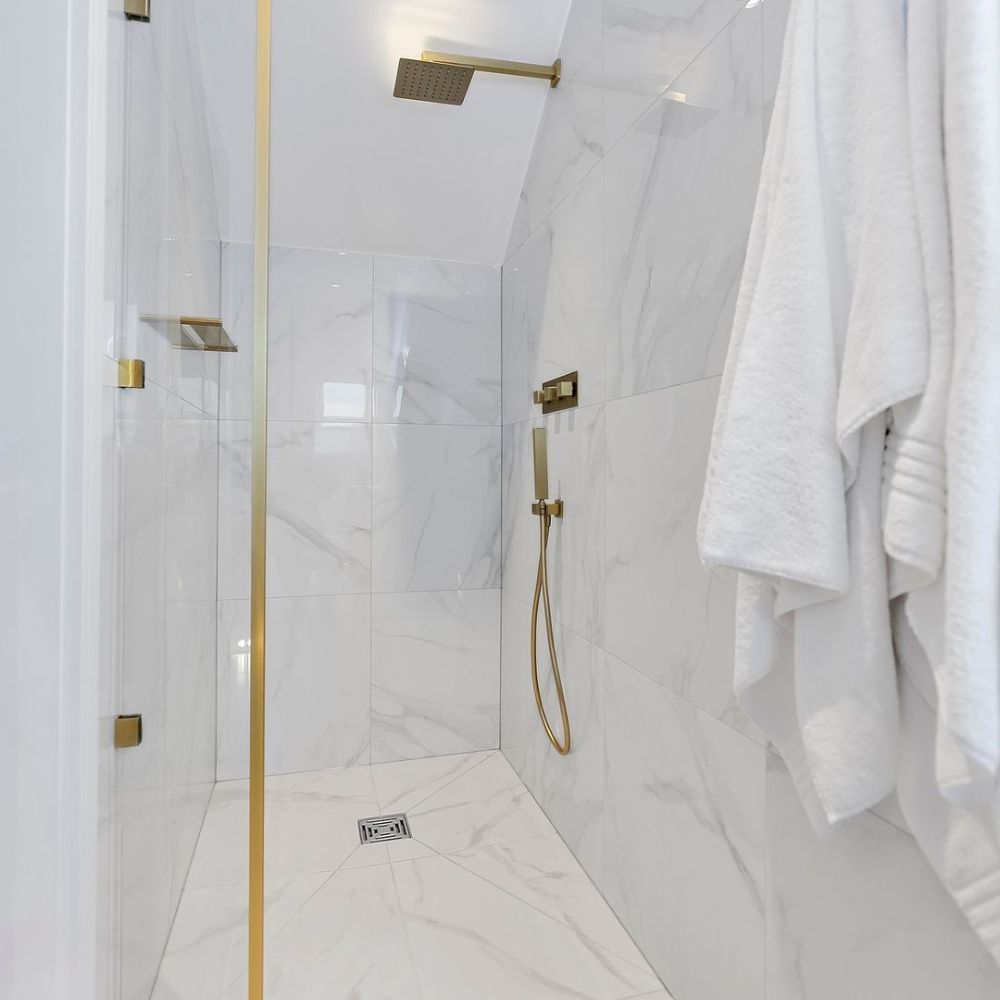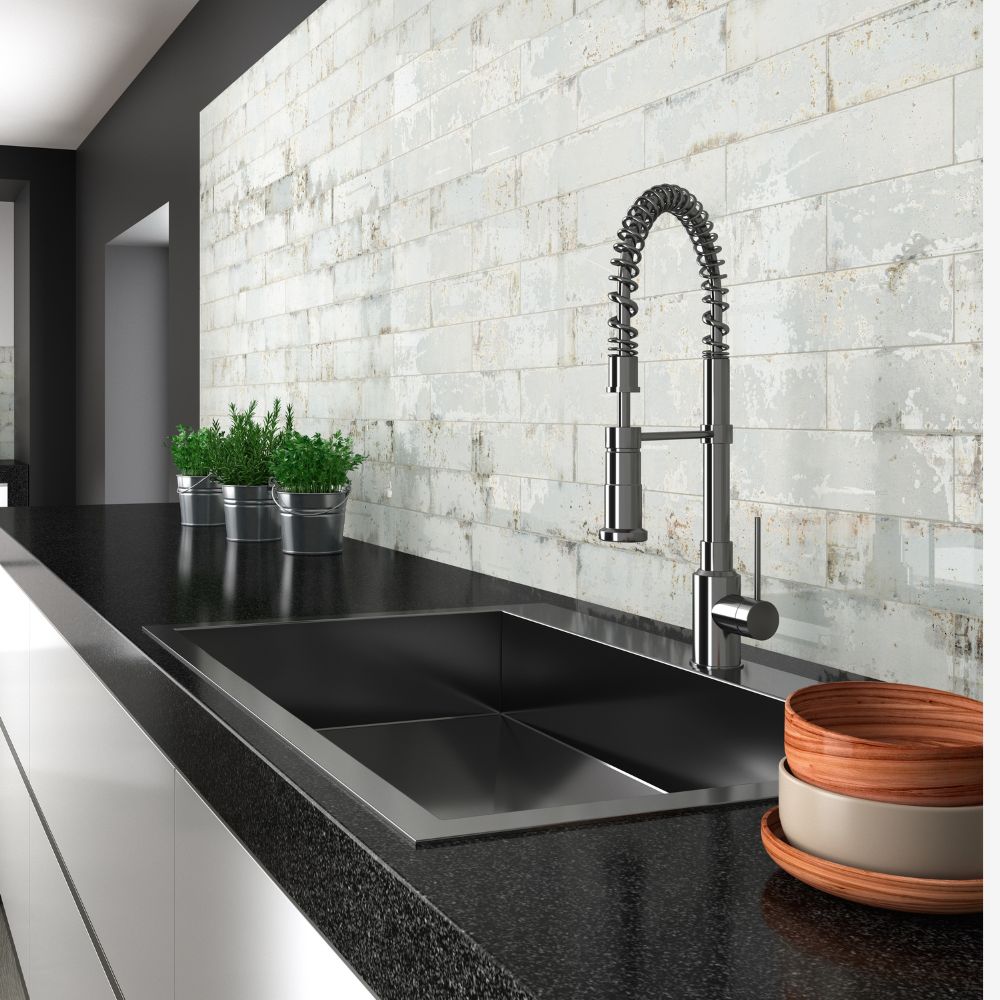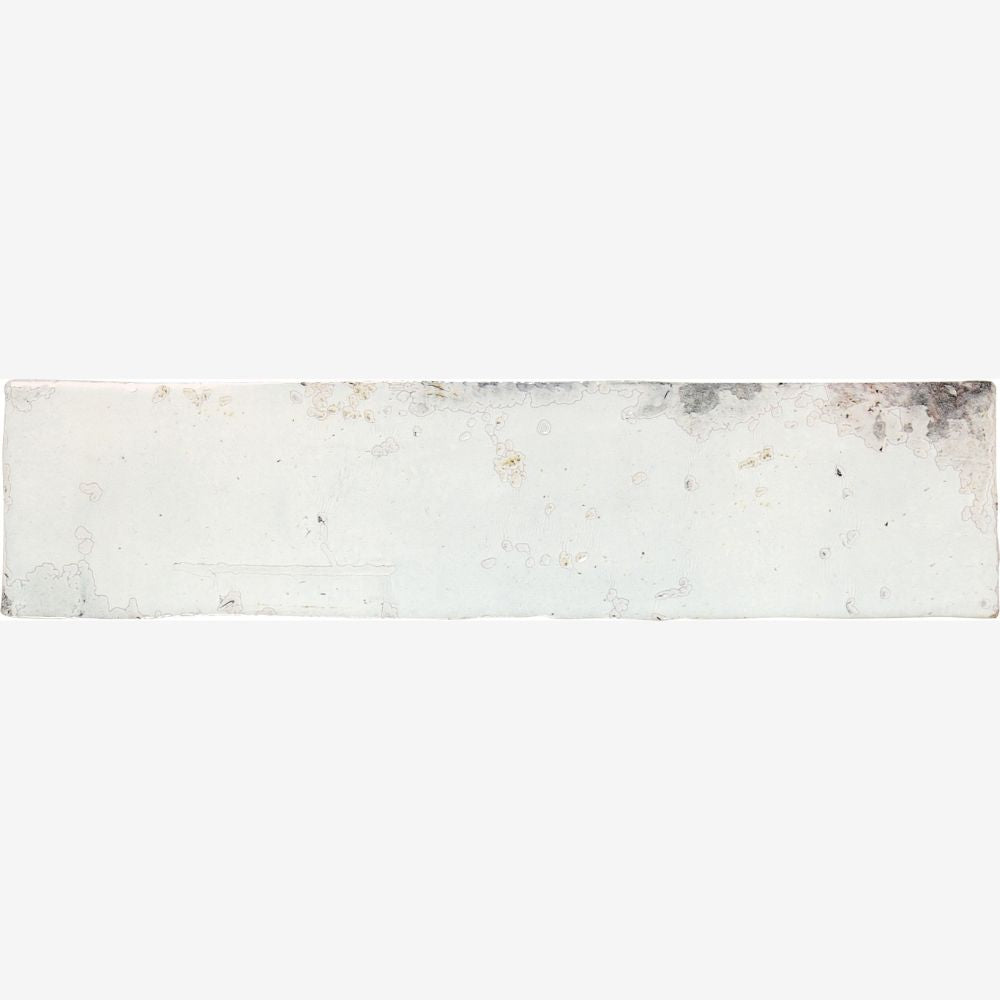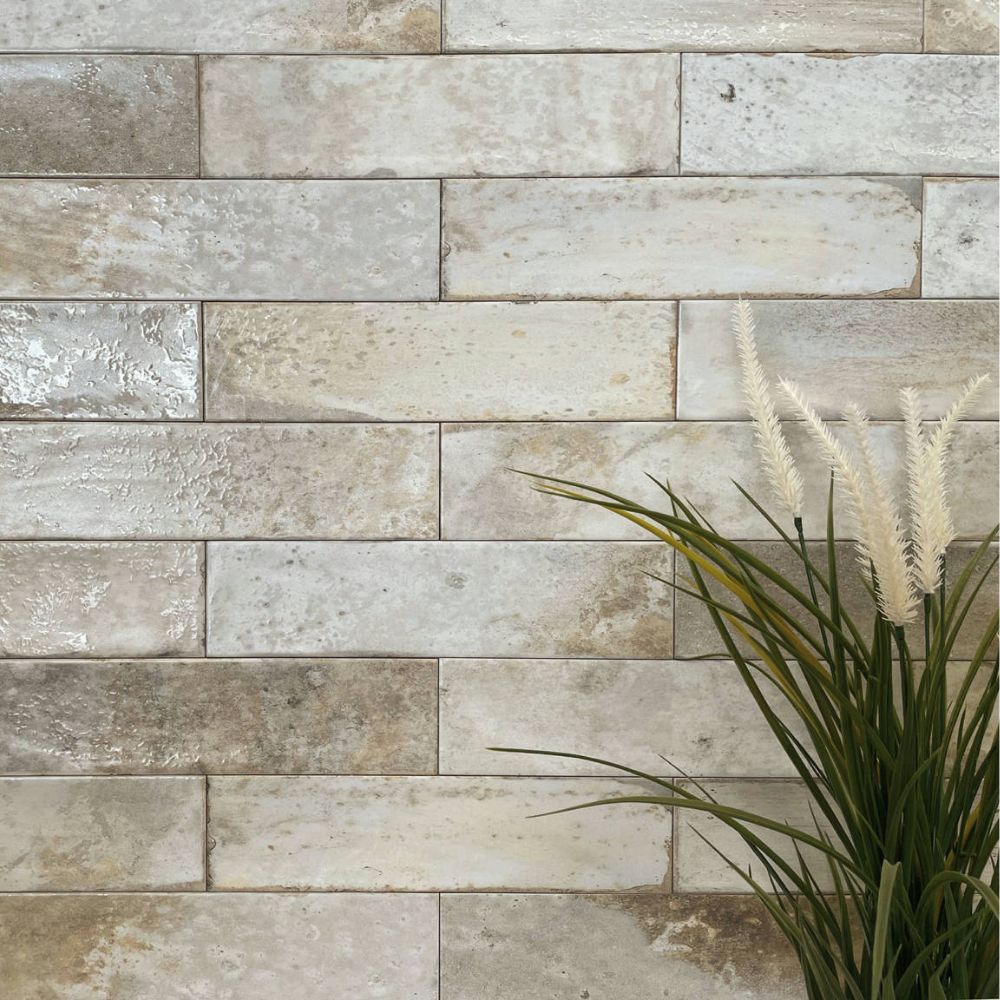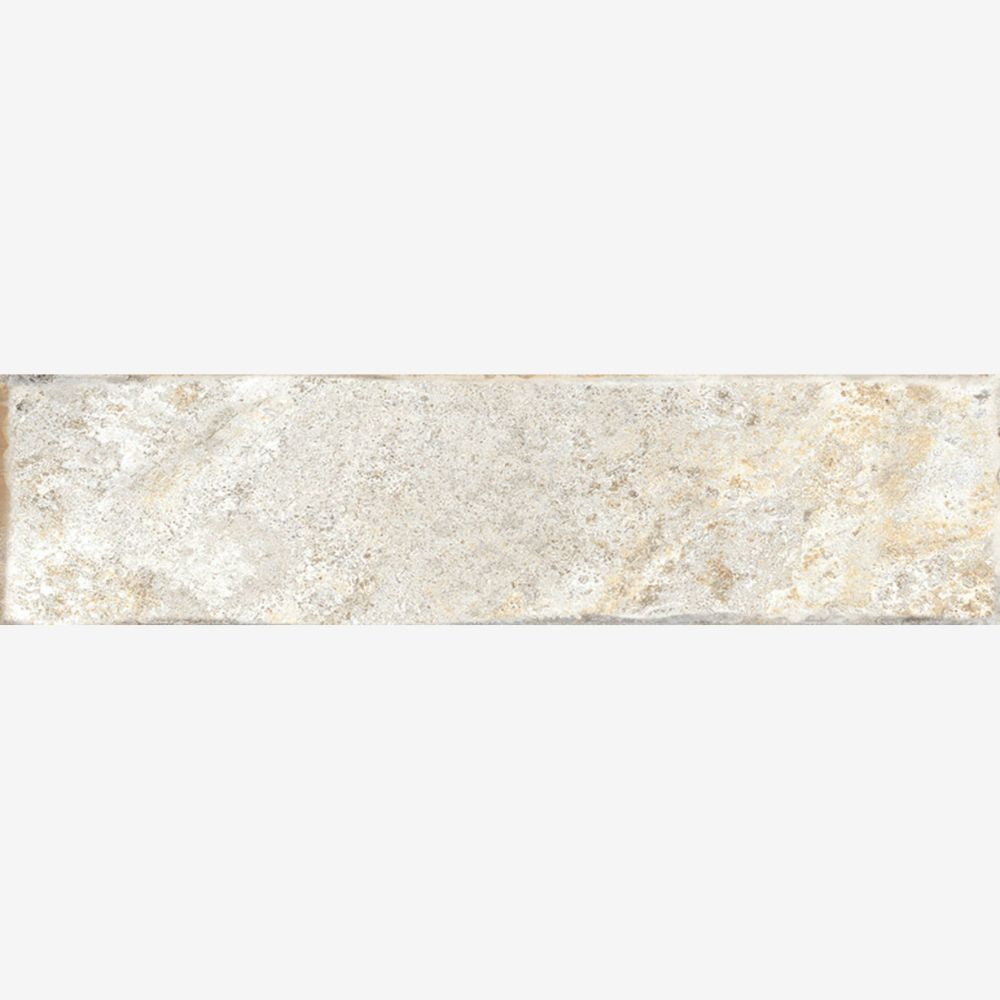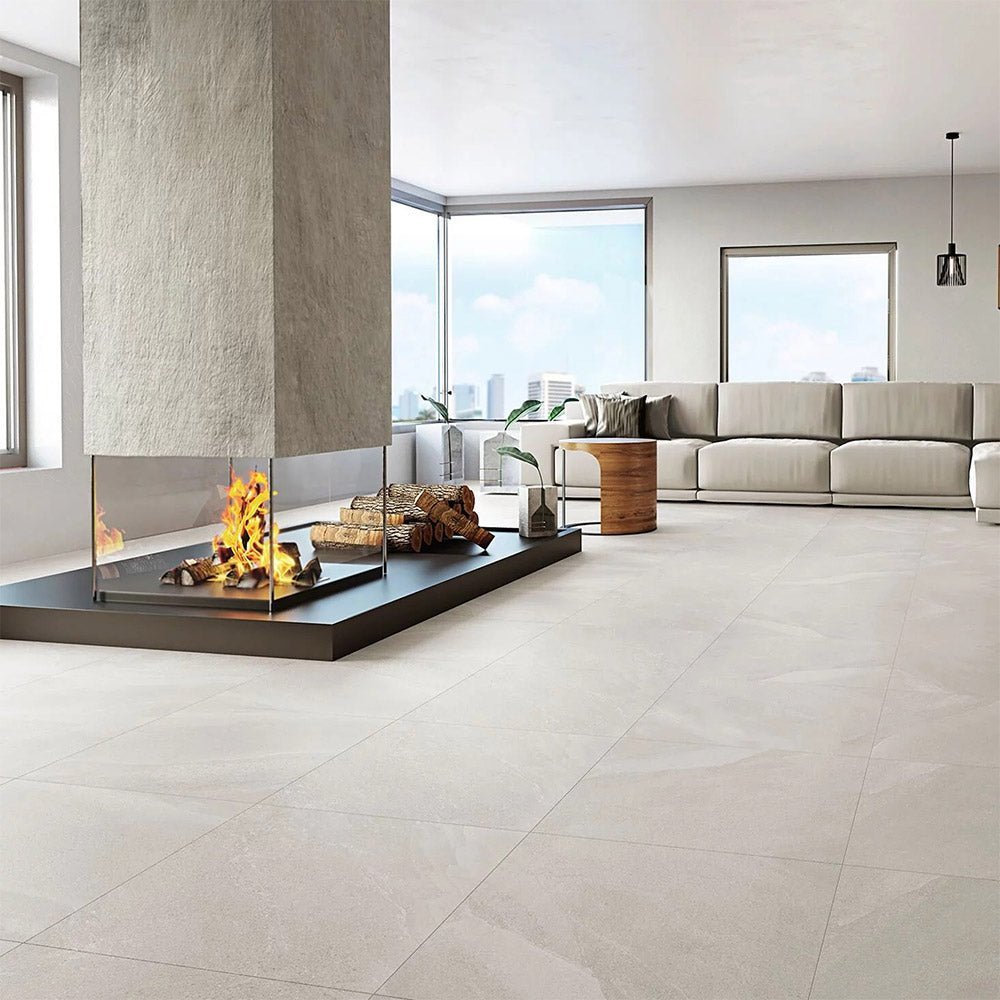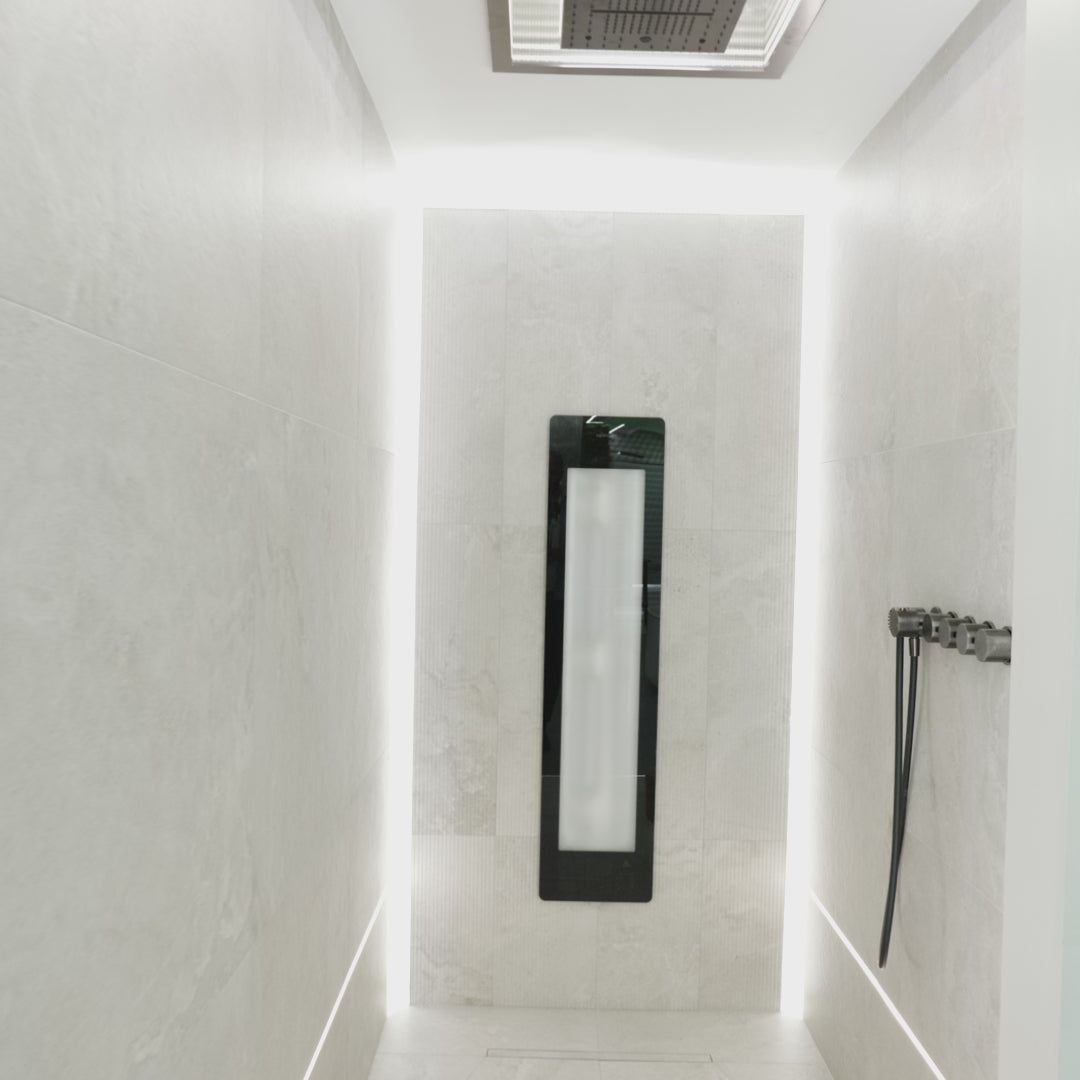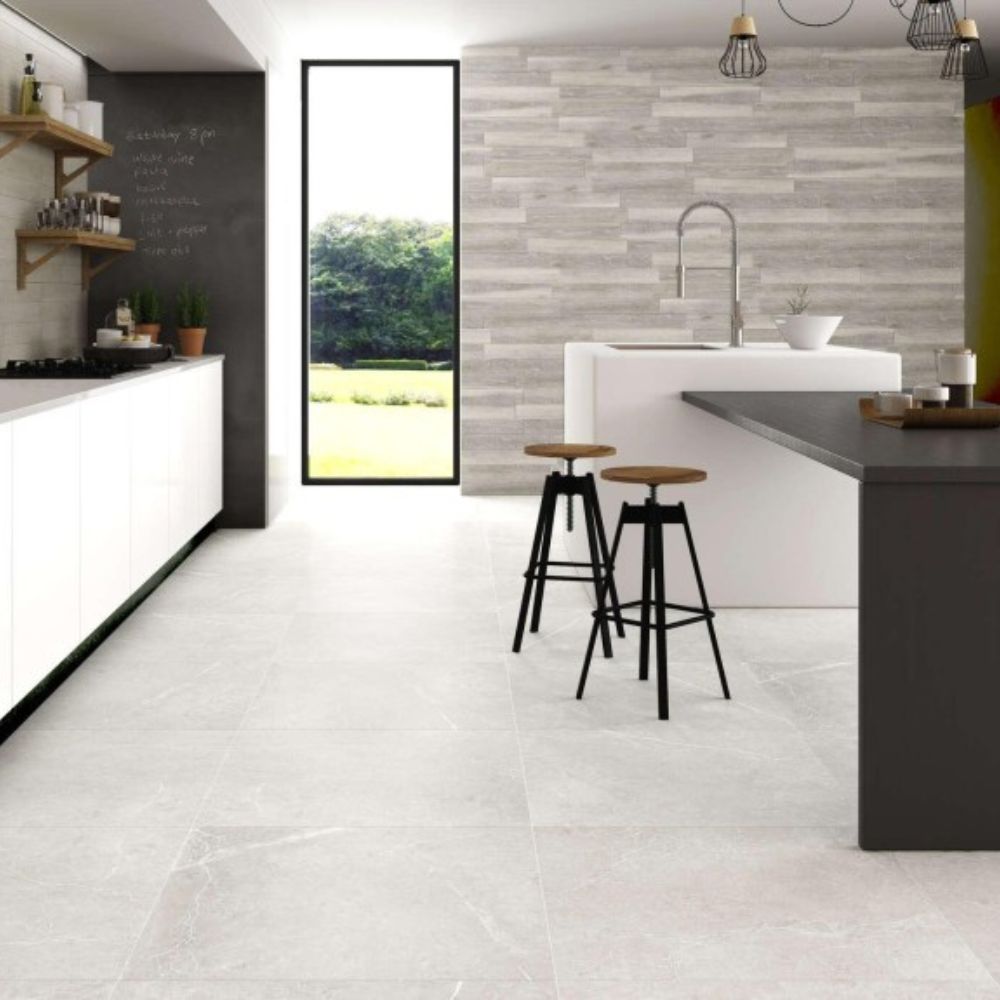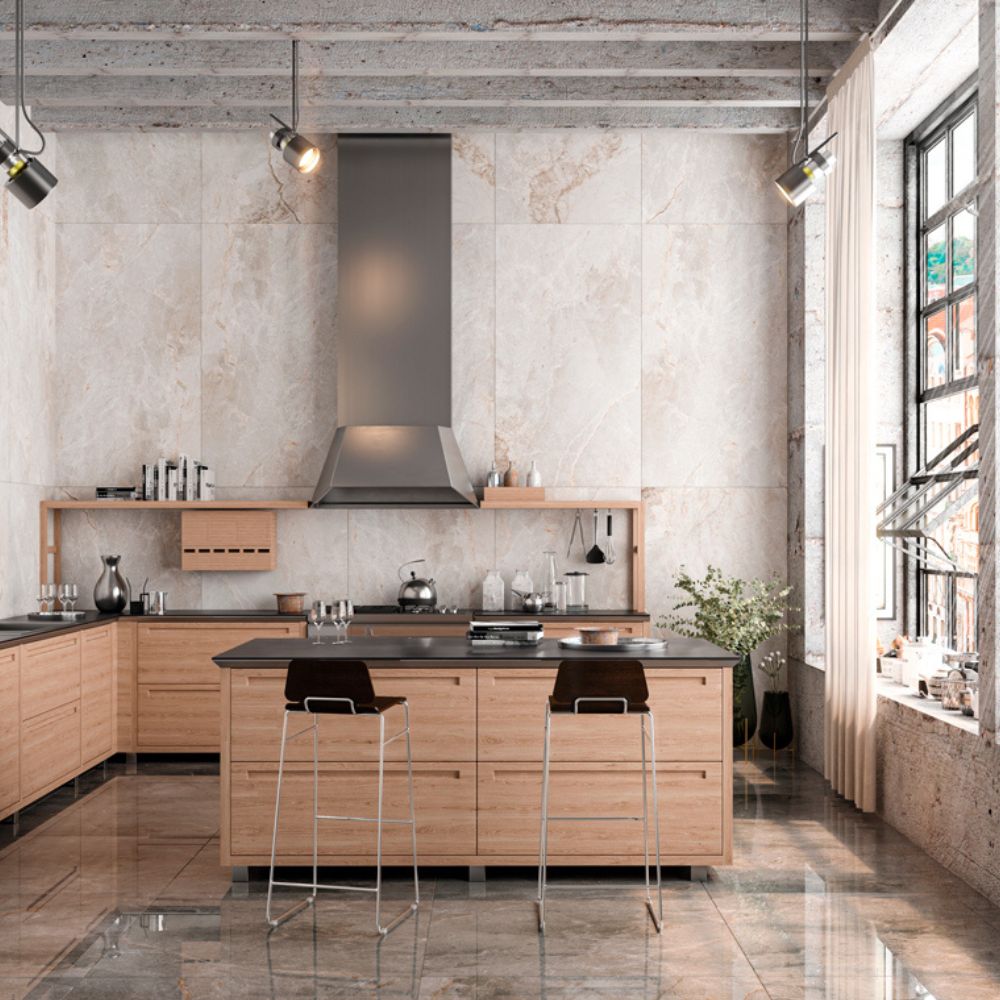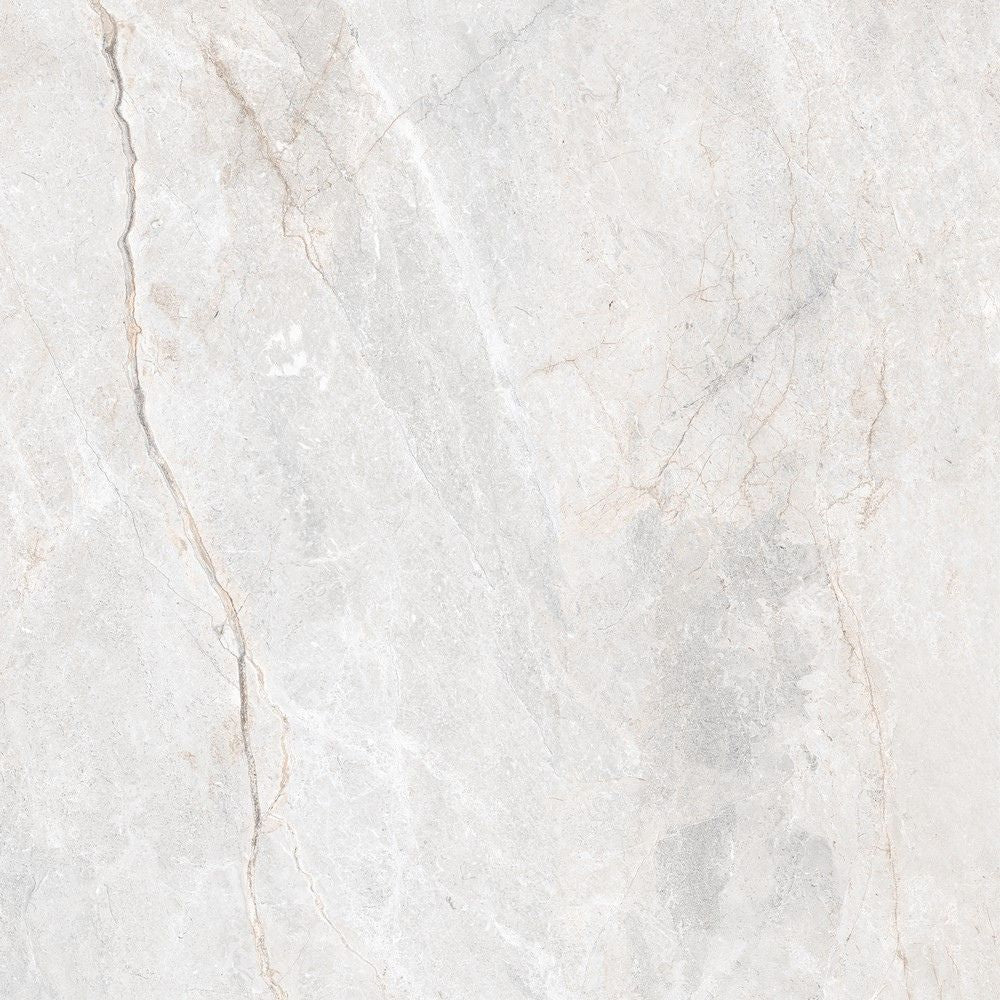
ROCCIA Design Centre
Opening Times:
Mon-Fri: 9:00am - 5:30pm
Sat: 9:00am - 5:00pm
Sun: 10:00am - 4:00pm
Bolton Showroom
Opening Times:
Mon-Fri: 8:00am - 5:00pm
Sat: 10:00am - 5:00pm
Sun: 10:00am - 4:00pm

Tiles On Display
Design & Ideas
Spotlight On: Scandinavian Home Trends
Scandinavian design has evolved from a trending buzzword to an enduring staple in modern interiors. Inspired by the serene natural environments of Sweden, Denmark, and Norway, the Scandi look is more than just a visual style, it’s a lifestyle. With its calming minimalism, emphasis on functionality, and connection to the outdoors, Scandinavian interiors offer a peaceful retreat from a fast-paced world. Scandinavian design trends continue to evolve, with the latest trends for 2025 focusing on new materials, colour palettes, and innovative approaches to home decor. Readers can expect insights into how the style adapts to modern living while maintaining its timeless appeal. Rooted in the principles of simplicity and practicality, this design ethos embraces natural elements and sustainable materials, creating spaces that are both beautiful and purposeful. The key characteristics of Scandinavian design include functionality, minimalism, and the use of natural materials. The use of light, neutral colours combined with earthy tones and layered textures brings warmth and emotional comfort, making Scandinavian homes inviting and timeless. In this guide, we’ll explore the core elements of Scandinavian home trends, particularly focusing on floor and wall finishes. Whether you’re refreshing a room or redesigning your entire home, discover how to embrace Nordic elegance through texture, tone, and subtle design detail. We’ll also highlight how to incorporate good craftsmanship and practical materials that bring both aesthetic appeal and functionality to your space, helping you create a home that reflects the best of Scandinavian design. Good design is at the heart of Scandinavian interiors, emphasizing quality, longevity, and accessibility. Additionally, we’ll discuss how Scandinavian style can be integrated with other design styles to create a cohesive and harmonious home environment. What Is Scandinavian Design? At its core, Scandinavian interior design is about balance, between simplicity and warmth, minimalism and texture, function and comfort. Pioneering Scandinavian designers have played a crucial role in shaping this style, emphasising functionality, craftsmanship, and timeless appeal. It embodies a philosophy that prioritises clean lines and uncluttered spaces while ensuring the environment feels welcoming and lived-in. The style celebrates natural materials and light, creating interiors that are both practical and aesthetically pleasing, which can add warmth to any space . Architecture has greatly influenced the clean lines and functional aspects of Scandinavian interiors, drawing on principles that connect form and function. Alvar Aalto, an iconic designer and architect, exemplifies the Scandinavian approach through his influential furniture, ceramics, and architectural contributions. The Role of “Hygge” in Home Design The Danish concept of hygge, loosely translating to comfort, cosiness, and contentment, sits at the heart of Scandi interiors. Every design choice should invite warmth and promote a sense of well-being. This is not achieved through clutter, but through intentional materials, soft textures, and gentle palettes that create a calm, liveable space enriched by indoor plants . Elements like plush wool throws, natural wood accents, and soft lighting all contribute to this feeling of hygge, making a home not just stylish but truly cosy and inviting. Emphasis on Natural Materials and Sustainability Scandinavian design deeply values natural elements such as wood, stone, and wool, which bring texture and life into a space. These materials are often sustainably sourced or reclaimed, with reclaimed wood being a popular sustainable choice in Scandinavian interiors for its role in reusing and repurposing materials. Incorporating sustainable materials not only enhances the aesthetic appeal but also aligns with the growing trend toward eco-conscious living. This approach ensures that beauty and function coexist with respect for the natural world. Functional Simplicity and Practical Purpose Functionality is a cornerstone of Scandinavian interiors. Every piece of furniture and decor serves a practical purpose, eliminating unnecessary ornamentation. This focus on usability means spaces are designed to support modern living, whether that’s through versatile furniture, clever storage solutions, or durable finishes that withstand daily wear. The result is a home that is both beautiful and highly liveable, perfectly suited to contemporary lifestyles and the way people live their lives today. The Importance of Light and Neutral Colour Palettes Given the long, dark Nordic winters, maximising natural light is essential in Scandinavian design. Interiors often feature large windows, minimal window treatments, and reflective surfaces to brighten spaces. The colour palette typically revolves around soft neutrals, whites, greys, and earthy tones, that enhance light and create a serene atmosphere. Using different shades of these colours helps to create depth and set the mood in each room. These hues pair beautifully with natural textures and occasional muted accents, contributing to a timeless style that adds depth without overwhelming the senses. Creating a Cosy and Inviting Atmosphere Despite its minimalist roots, Scandinavian design never feels stark or cold. Through layering textures, such as combining smooth surfaces with woven textiles and natural fibres, interiors gain warmth and personality. Thoughtful home decor choices, including accessories like indoor plants, handcrafted ceramics, and subtle artwork, add life and character while maintaining the style’s clean aesthetic. This thoughtful layering fosters a sense of comfort and emotional well-being, making Scandinavian homes a true sanctuary, offering more inspiration for creating inviting spaces . Building a Scandi Foundation: Walls and Floors First Flooring: Minimal, Durable, Organic Forget carpets. Scandinavian floors are hard-wearing and low-maintenance, with a preference for natural materials like wood and stone. Porcelain tiles with wood-effect finishes are perfect for achieving this look with greater resilience and easier care. Keep tones light, whitewashed, pale oak, and ash tones are especially popular, as they help to reflect natural light and make spaces feel more open and airy. These flooring choices not only add warmth but also bring a timeless style that complements the overall aesthetic of Scandinavian interiors. To further enhance the minimalist and cosy feel, consider adding side tables in natural materials like bark or tree stump designs, which pair beautifully with Scandinavian flooring and contribute to a calming, earthy atmosphere. Walls: Neutral Backdrops with Subtle Texture Walls should act as a neutral canvas, but that doesn’t mean they lack texture. Consider stone-effect or concrete-look tiles with a matte finish, offering depth without distraction. Layering different tones of the same colour can add softness to the space while retaining a clean aesthetic. These textured finishes add an organic, tactile quality that enhances the natural elements of the room and creates a harmonious backdrop for furniture and decor. Such thoughtful wall treatments contribute to the emotional comfort and cosy atmosphere characteristic of Scandinavian homes. Keep Cool: Embracing Pale Tones The simplest way to adopt Scandinavian design is by introducing cool-toned hues into your palette. Whitewashed woods, faded stone, muted greys, and icy blues are all popular options, with muted greys and icy blues being a top choice for Scandinavian interiors in 2025 as they reflect the Nordic landscape. Choose large porcelain tiles with a matte finish and soft veining to echo this understated elegance. For instance, Roccia’s Global range captures the subtle variation and texture ideal for Scandinavian serenity, while Nordica offers a deeper charcoal variation to add contrast without losing cohesion. Forest Inspiration: Nature as a Muse Despite the prevalence of pale tones, Scandinavian interiors are not void of warmth. The inspiration of the Nordic forest is evident in red-toned and honeyed woods. Incorporating biophilic design principles, these interiors use natural elements and greenery to create tranquil, nature-inspired spaces that promote relaxation and well-being. When working with darker or warmer flooring, keep wall finishes minimal and accessories soft to avoid overwhelming the space. Choosing Wood-Effect Tiles for Authenticity The key is selecting wood-look porcelain tiles with realistic graining and natural tones, such as Roccia’s Cross Wood collection. These tiles replicate the raw texture of timber without the maintenance requirements, aligning perfectly with Scandinavian practicality. Concrete Calm: Bringing Subtle Structure Cool, industrial elements like concrete finishes are another hallmark of Scandi style. These finishes are best used in light grey or warm taupe tones, avoiding the coldness of overly sterile surfaces. How to Use Concrete-Effect Tiles in Scandi Design Concrete-look tiles are ideal for both floors and walls. Their textured surfaces and organic imperfections bring a grounded feel to the room. Tiles like Roccia’s La Roche range offer tactile beauty with colours that harmonise effortlessly with wood tones, linen textiles, and soft furnishings. Scandi Pattern: Playful, But Balanced Pattern does have a place in Scandinavian interiors, when done right. The key is restraint: limit boldness to one area and keep colour palettes grounded in pastels or naturals. Adding Visual Interest Through Texture and Geometry Subtle patterning can be introduced through tiles that mimic marble veining or geometric arrangements in soft white or grey. For example, Roccia’s Scot tiles offer a refined take on pattern through natural stone textures, while Brick Lane tiles provide a playful, modern spin ideal for splashbacks or bathroom walls. Material Matters – Choosing the Right Finish Matte vs Polished Surfaces In Scandinavian interiors, matte finishes are the dominant choice. They create a more relaxed and organic feel, avoiding glare or excessive reflectivity. Matte tiles also tend to better mimic natural materials such as wood, stone, and concrete, enhancing the authentic, earthy vibe that Scandinavian design celebrates. However, a lightly polished surface can be used sparingly to reflect light and add a sense of space, particularly in compact areas or rooms with limited natural light. The trick is to choose tiles with a soft sheen rather than a high gloss, which maintains the understated elegance without overpowering the calm atmosphere. This subtle contrast between matte and polished surfaces can add depth and interest to a room, creating a balanced interplay of textures that enriches the overall aesthetic. When selecting finishes, consider the function of the space as well. Matte surfaces are often more forgiving with fingerprints and smudges, making them practical for high-traffic areas, whereas polished finishes can highlight imperfections but offer a more refined look. Combining both finishes thoughtfully can bring harmony and functionality to your Scandinavian home design. Layering Textures in a Minimalist Space One of the secrets to a successful Scandinavian room is layered texture. When colour is limited, texture does the heavy lifting to create visual interest and warmth. Using Tile Texture to Your Advantage Choose stone-effect tiles with natural fissures or grain to introduce organic, tactile elements that mimic the textures found in nature. Combine smooth matte tiles with rougher, tactile materials such as natural wood or woven textiles to create a balanced contrast that adds depth. Create dimension by alternating tile sizes or laying patterns like herringbone or staggered brick, which subtly break up flat surfaces while maintaining a clean aesthetic. Incorporate textured wall tiles or panels in key areas to add a sculptural element without overwhelming the minimalist design. Layer soft textiles, like wool rugs, linen cushions, or knitted throws—against harder surfaces to enhance cosiness and tactile richness. This layered approach allows a room to feel curated and lived-in, without sacrificing the simplicity that Scandinavian design demands. By thoughtfully mixing textures, you add warmth and personality to minimalist spaces while keeping the overall look clean, functional, and inviting. Designing for Functionality and Lifestyle While aesthetics are important, Scandinavian design is deeply rooted in functionality and practicality. Every design choice should enhance daily living, making spaces not only beautiful but also highly usable. When selecting surfaces, prioritise materials that support your lifestyle needs, water-resistant flooring is essential for kitchens and bathrooms to handle spills and humidity, while stain-resistant finishes are ideal for busy households with children or pets. Durable materials that withstand wear and tear ensure your space remains looking fresh and inviting over time. Consider how each room is used and tailor your material choices accordingly. For example, in the living room, functional and aesthetic Scandinavian design choices are especially important to create a cosy, inviting, and practical space for relaxation and gathering. Opting for easy-to-clean tiles in high-traffic areas can save time and effort, while textured surfaces can provide slip resistance and add subtle visual interest. Scandinavian design encourages thoughtful selection that balances style with purpose, reflecting the ethos of living well without unnecessary fuss. Always consider your lifestyle needs first, and let style follow function. This is the true ethos of Scandi living, creating homes that are not only visually serene but also genuinely comfortable and practical for everyday life. Final Thoughts: Crafting a Scandi-Inspired Space with Roccia Whether you’re drawn to the calming tones, the natural materials, or the clean lines of Scandinavian design, Roccia offers a curated range of wall and floor tiles to help you achieve the look. From pale wood-effects to textured concrete and minimalist patterns, every tile is selected with design integrity and durability in mind. Visit your nearest Roccia showroom in Preston or Bolton to explore our full collection and speak with our design experts. We’re here to help bring your vision to life, whether you’re transforming one room or reimagining your whole home. For more inspiration and ideas on Scandinavian home trends, visit the Roccia website or stop by our showroom to discover our latest galleries and resources.
Using Large Format Tiles in Small Spaces
Using Large Format Tiles in Small Spaces Finding the perfect tiles to enhance a small space can often be challenging, especially when you're drawn to the stunning array of large format tiles available. Given the limited space, you might feel compelled to stick with smaller tiles, but this isn’t always the most appealing option, as larger tiles can help your room feel larger . Fortunately, that’s not the only way to go, as you’re about to discover. This article will explore how to effectively use large format tiles in small spaces and highlight the numerous advantages they bring, from enhancing the visual appeal to improving the functionality of your rooms. You'll learn design tips, practical considerations, and expert advice to help you confidently choose and install large format tiles that make your small spaces feel larger, brighter, and more stylish. Why Choose Large Format Tiles in Small Spaces? Rethinking Tile Size for Compact Rooms Large format tiles, typically defined as tiles larger than 600x600mm, might seem like an unusual choice for small spaces. Yet, when used correctly, they simplify the visual field, reduce grout lines, and create the illusion of spaciousness. For a small room, large format tiles can dramatically make a room look more unified and expansive. In small bathrooms, hallways, kitchens, and utility rooms, large tiles can transform cramped areas into sleek, modern spaces that feel airy and open. By minimising interruptions caused by numerous grout lines, these big tiles help the eye to move smoothly across surfaces, making the entire room appear more cohesive and less cluttered. The choice of tile size and finish can significantly influence the overall room look in a small room, especially when the tiles are installed in matching colours and finishes, further enhancing the sense of continuity and flow. Additionally, large format tiles often come in a variety of popular styles and finishes, such as polished ceramic tiles or stone effect porcelain, allowing homeowners to tailor the look to their personal taste while maximising the spacious feel of even the smallest rooms. Characteristics of Large Format Tiles Large format tiles are defined by their impressive size, typically starting at 600 x 600mm and extending up to 2.7 x 1.2m or even larger. This substantial scale is what sets them apart from smaller tiles and makes them an excellent choice for homeowners looking to create a spacious feel in any room. With fewer grout lines breaking up the surface, large format tiles deliver a sleek, seamless look that instantly modernizes both walls and floors. These format tiles are available in a wide variety of materials, including durable porcelain, classic ceramic, and luxurious natural stone, allowing you to achieve anything from a contemporary, minimalist style to a more traditional, elegant finish. The versatility of large format tiles means they are suitable for almost any space, whether you want to create a striking feature wall, a smooth bathroom floor, or a cohesive look throughout your home. Their large size helps to visually expand smaller rooms, making them feel more open and less cluttered compared to spaces tiled with smaller tiles. With a range of colours, patterns, and textures to choose from, large format tiles offer endless possibilities for creating a modern, spacious, and stylish environment. The Spatial Benefits of Large Format Tiles Fewer Grout Lines = A Larger Feel One of the key advantages of large format tiles is the reduced number of grout lines. Grout lines naturally create visual breaks across a surface. In small rooms, too many lines can make the space feel busy, cluttered, and even smaller. Reducing grout lines helps improve the small room feel by making the area appear less cluttered and more open, thereby enhancing the available floor space. Large tiles minimise these interruptions, creating expansive, continuous surfaces. For best results, choose a grout colour that closely matches your tile. This further reduces visual fragmentation, allowing the eye to travel smoothly across walls and floors. Seamless Floor-to-Wall Transitions Using large format tiles on both the wall and floor enhances continuity. Incorporating large wall tiles creates a seamless transition between surfaces, enhancing the sense of space and contributing to a luxurious, contemporary look. This seamless design trick blurs spatial boundaries, making the entire room feel more cohesive and, by extension, larger. Smaller tiles, while ideal for feature walls or statement floors, tend to break up small rooms and can feel fussy when space is limited. In contrast, large wall tiles help create a more cohesive and expansive look, making even compact spaces appear more open and unified. Choosing the Right Tile Colour Light-Coloured Tiles to Reflect and Expand Colour plays a critical role in spatial perception. In small rooms, lighter tones naturally open up the space. Light-coloured tiles, such as whites, creams, soft greys, and beiges, reflect more light around the room, amplifying both natural and artificial lighting. These tiles can reflect light effectively, making the room appear more open and airy. Opting for pale tiles with subtle patterns or polished finishes can intensify this effect. White-on-white schemes are especially effective in bathrooms and utility areas, where cleanliness and brightness are prized. Make the Most of Natural Light If your small space has windows, maximise this advantage by pairing them with light-reflecting tiles. Natural daylight bouncing off glossy surfaces helps expand the room visually. Using light-reflecting tiles in living rooms can help create a more open and inviting atmosphere. For windowless rooms, use well-placed artificial lighting, such as recessed spotlights or LED strips, to complement your light tile choices and maintain a sense of openness. Expert Design Techniques with Large Tiles Install Tiles Diagonally for Dynamic Impact One of the most underused design strategies is diagonal tile installation. Laying large tiles diagonally, sometimes called “on point,” can dramatically alter the perceived proportions of a room. In a small bathroom, diagonal installation of large format tiles can make the space appear larger and more stylish, challenging the misconception that big tiles shrink small rooms. Diagonal tiling interrupts the typical linear perspective, drawing the eye outward and making the space feel broader. This trick works exceptionally well in small bathrooms, entryways, and kitchens, helping break up rectangular floor plans and maximising spatial perception. While diagonal installation works with most tile sizes, the effect is particularly powerful when using large format tiles, due to the expansive surfaces they create. Use Rectified Edges for a Sleek Finish Large format tiles with rectified (machine-cut) edges allow for narrower grout joints. This enhances the seamless effect, creating a smooth, modern finish that elevates small rooms. Rectified wall tiles are especially effective for achieving a seamless and modern appearance in small spaces, making walls look more spacious and luxurious. Look for tiles specifically labelled as rectified to take advantage of this feature. Go Glossy for Maximum Light Reflection In tight spaces, gloss finish tiles can reflect both natural and artificial light, further opening up the room. Polished porcelain and glazed ceramic large format tiles are popular options when pursuing this high-reflectivity effect. Avoid overly textured or matte finishes if your primary goal is spatial expansion. Installation Tips for Large Format Tiles When it comes to installing large format tiles, attention to detail is key to achieving a flawless, long-lasting result. Because these tiles cover more surface area and have fewer grout lines, any imperfections in the subfloor or wall can become more noticeable. That’s why it’s essential to ensure the surface is perfectly level, clean, and stable before you begin. Employing a professional tiler is highly recommended, as they have the expertise and specialised equipment, such as large format tile cutters and levelling systems, needed to handle these bigger tiles with precision. Choosing the right adhesive is also crucial; high-strength, flexible adhesives like epoxy-based products are often best suited for large format tiles, helping to create a strong bond and prevent movement over time. When it comes to grout, select a grout colour that closely matches your tile to maintain a smooth, seamless appearance and minimise visual breaks. Proper installation not only enhances the finished look but also ensures your tiles remain secure and beautiful for years to come. Practical Benefits of Large Format Tiles in Small Spaces Beyond aesthetics, large format tiles offer practical advantages: Easy Cleaning: Fewer grout joints mean less surface area for dirt and grime to collect, making large tiles easier to clean. Durability: Porcelain large format tiles are particularly hard-wearing, ideal for high-traffic small spaces like hallways and kitchens. Versatility: Available in countless designs, from marble-effect to concrete-look finishes, large tiles suit both classic and contemporary interiors. Underfloor Heating Compatibility: Large format tiles work exceptionally well with underfloor heating systems, providing a comfortable, seamless, and modern finish that is easy to maintain. Many suppliers keep a wide stock of large format tiles in various sizes and finishes, making it easy to find the right option for your project. Where to Use Large Format Tiles in Small Homes Large tiles can work beautifully in a variety of small rooms. Consulting tile experts can help you select the best large format tiles and layouts for your specific needs: Compact Bathrooms: Floor-to-wall large tiles streamline the space, reducing clutter and visual noise. Compared to small tiles, large format tiles use fewer grout lines, resulting in a more seamless, spa-like atmosphere that feels open and inviting despite the limited square footage. Narrow Hallways: Continuous large tile flooring elongates corridors, making them feel wider and less confined. By minimizing grout lines and using light-coloured tiles, these spaces can appear brighter and more welcoming. Small Kitchens: Large floor tiles simplify the layout, while matching splashbacks can enhance uniformity and create a cohesive look. This approach helps to visually expand the kitchen area, making it feel less cramped and more functional than if small tiles were used. Utility Rooms and Laundries: Durable, easy-to-clean large tiles add functionality without sacrificing style. Their robust nature withstands heavy use, while the reduced grout lines make maintenance quicker and easier, perfect for busy households. Why Choose Roccia for Large Format Tiles? At Roccia, we offer one of the North West’s most extensive collections of large format wall and floor tiles. Whether you’re after marble-effect porcelain for a luxury en suite or concrete-style tiles for a contemporary kitchen, our curated range ensures you’ll find the perfect solution for your space. Visit our showrooms in Preston or Bolton, where our expert team will guide you through options tailored specifically to your design goals and space constraints. For further information about our large format tile collections and services, please contact Roccia. Transform Small Spaces with Large Format Tiles In summary, large format tiles aren’t just for big, open-plan rooms. When used intelligently, they can unlock the potential of small spaces, enhancing light, reducing visual clutter, and creating a sophisticated, modern aesthetic. From choosing pale tones and seamless layouts to considering diagonal installations and gloss finishes, every design choice plays a role in expanding the feel of your compact rooms. Ready to maximise your space? Contact Roccia or visit our showrooms to explore our premium large format tile collections and expert advice.
Kitchen Worktop Materials: What Should I Choose? An Expert Guide
Kitchen Worktop Materials: What Should I Choose? An Expert Guide Selecting the perfect natural material for your kitchen worktops is one of the most crucial decisions in any renovation or design project. Worktops aren’t simply surfaces, they’re the functional foundation of your kitchen and play a significant role in shaping the overall look and feel of the space. In this comprehensive guide, we explore every major worktop material, including engineered stone, in detail, offering expert advice on their strengths, limitations, maintenance requirements, and design potential. Whether you’re a homeowner planning your dream kitchen or a designer working on a luxury project, this guide will help you make a well-informed choice. Choosing kitchen worktops involves considering essential qualities such as durability, heat resistance, stain resistance, and ease of maintenance. With a wide range of kitchen worktop options available from natural stone to engineered stone and wood grains, you can find the best kitchen worktops that perfectly match your style preferences and practical needs. When comparing options, including quartz worktop pros t's important to consider which is the best kitchen worktop for your specific requirements, whether you prioritize durability, aesthetics, or budget. Understanding the key factors that influence your decision, including cost effectiveness, longevity, and how well a material is highly resistant to stains and scratches, will ensure your kitchen worktops remain both beautiful and functional through everyday use and busy kitchens. Evaluating these aspects will help you determine the best material for your kitchen worktop, ensuring you make a choice that balances style, practicality, and long-term value. Why Your Worktop Material Choice Matters Kitchen worktops need to be both visually stunning and practical enough to withstand everyday life. From meal preparation to family gatherings, your worktops are constantly in use, making their material a central consideration. Choosing the right heat resistant material affects not just the kitchen’s functionality, but also its longevity, ease of maintenance, and resale value. Equally important is how the worktop complements your cabinetry, splashbacks, flooring, and overall interior style. The choice you make will influence the overall ambiance of your kitchen, whether you prefer a sleek modern look, a warm traditional feel, or something uniquely eclectic. The worktop material you select plays a crucial role in defining your kitchen design, as it ties together the aesthetic and functional elements to create a cohesive space. Additionally, selecting a high-quality, hard wearing kitchen worktop material can save you money and effort in the long run by reducing the need for repairs or replacements. Considering factors such as resistance to stains, scratches, heat, and moisture will help ensure your worktops remain beautiful and functional for years to come. Natural Stone Worktops: Elegant Durability Granite Worktops: Strength from Nature Granite is highly sought after for its durability and natural beauty. Each slab is unique, featuring intricate veining and organic patterns that add character to any kitchen. Available in a wide range of colours and patterns, granite enhances visual appeal. Though naturally heat and scratch resistant, granite is porous and requires sealing at installation and periodic resealing to prevent stains and bacteria. When properly sealed, it is water resistant and ideal for busy kitchens. It can withstand high temperatures, so hot pans won’t cause damage. Despite some maintenance, granite remains a popular choice for its long-lasting performance and timeless elegance. Quartz Worktops: Engineered for Modern Life Quartz worktops combine natural quartz crystals with resin to create a durable, non-porous surface. Engineered quartz may include other materials to enhance appearance and properties. Unlike granite, quartz doesn’t need sealing and resists stains and scratches, as well as bacteria. Its durability and design versatility make it ideal for busy family kitchens prioritizing hygiene and low maintenance. Cleaning with soapy water is recommended; harsh chemicals should be avoided. Quartz offers consistent colouration, appealing to modern designs. Available in many shades and finishes, quartz suits seamless, minimalist aesthetics. However, quartz is also extremely durable, but it is sensitive to heat, so trivets are necessary to protect from hot pans. Wooden Worktops: Warmth and Natural Character Solid Hardwood: A Classic Choice Hardwood worktops, such as oak, walnut, and cherry, provide kitchens with warmth, texture, and depth, offering a timeless appeal . Their rich tones and natural grain patterns suit both traditional and contemporary designs. Over time, hardwood develops a patina that enhances its rustic charm. That said, solid wood worktops demand commitment to care. Regular oiling is required to prevent moisture penetration and warping. Scratches and surface marks are inevitable but can be sanded down and refinished, making hardwood a renewable and sustainable choice for homeowners who appreciate its evolving beauty. Butcher Block: Rustic Practicality Butcher block worktops, constructed from bonded strips of wood, offer a similar natural aesthetic to hardwood but with a slightly more casual, rustic appeal. Their tactile surface is ideal for food preparation and chopping tasks, though it's worth noting that this daily use will gradually mark the surface. Ongoing maintenance is essential with butcher block. Spills should be wiped promptly, and regular oiling will help retain the worktop’s structural integrity and appearance. When paired with matching timber cabinetry or contrasting contemporary finishes, butcher block worktops can create a warm, welcoming atmosphere in any kitchen. Composite and Laminate Worktops: Modern Solutions Composite Stone: Durable and Design-Focused Composite worktops are created from a blend of natural minerals and resins, unlike solid wood resulting in a surface that combines aesthetic versatility with outstanding durability. In many solid surface worktops, acrylic resins are used to enhance durability, create a non-porous surface, and allow for a seamless appearance. These worktops are non-porous, making them resistant to stains and bacterial growth, and they stand up well to everyday wear and tear. Unlike natural stones, composite worktops offer consistency in pattern and colour, which appeals to those looking for a cohesive, uniform design. This consistency also enables a seamless look, with joints that are often invisible, providing a smooth, continuous surface. They’re also relatively heat-resistant, although like quartz, it’s advisable to avoid placing hot pans directly on the surface. In contemporary kitchens where practicality and style need to coexist, composite worktops are a reliable and visually adaptable choice. Laminate Worktops: Budget-Friendly Versatility Laminate worktops are a practical solution for homeowners seeking affordable yet attractive surfaces. Made from layers of decorative paper and resin bonded to a chipboard core, laminate worktops are available in a wide variety of colours, patterns, and finishes, including those that replicate natural stone or wood. Although laminate lacks the heat resistance and scratch durability of stone or composite materials, its low cost and ease of maintenance make it a popular choice for family kitchens or rental properties. Simply wiping the surface with a damp cloth keeps it looking clean and fresh. Marble Worktops: A Statement of Luxury The Unique Beauty of Marble Marble worktops are synonymous with luxury. Each slab boasts unique veining and rich colour variations, and this individuality makes marble a showstopping feature in any kitchen. However, marble comes with significant maintenance considerations. Softer and more porous than granite or quartz, marble is prone to staining, scratching, and etching from acidic foods and liquids. To preserve its beauty, it requires regular sealing and gentle cleaning practices, avoiding harsh cleaners . When properly maintained, marble countertops can retain their elegance and durability for many years. Designing with Marble Marble works best in kitchens where its aesthetic value outweighs its practical limitations. For those drawn to its timeless elegance, consider using marble selectively, perhaps on a kitchen island or as a statement splashback, while opting for more resilient materials elsewhere in the space. Exploring Specialist Materials for Unique Kitchens Stainless Steel Worktops: Professional-Grade Performance Favoured in commercial kitchens, stainless steel worktops bring industrial style and professional performance to modern homes. Heat-resistant, stain-proof, and antibacterial, stainless steel is a highly practical choice for serious home cooks. However, it scratches easily and fingerprints show up readily. For those who appreciate an industrial, urban aesthetic, these characteristics often add to the material’s charm, creating a soft patina over time. Concrete Worktops: Bespoke Minimalism Concrete worktops provide a unique, architectural look, with each surface cast individually for bespoke designs. Their raw, tactile texture appeals to lovers of modern minimalism and industrial design. While concrete is naturally porous, sealing it can protect against stains and moisture. Hairline cracks may develop over time, which some homeowners embrace as part of its character. Worktop Thickness: Finding the Right Profile for Your Kitchen When selecting your ideal kitchen worktop, thickness is more than just a technical detail, it’s a design statement that influences both the appearance and performance of your space. Worktops are typically available in thicknesses ranging from a sleek 20mm to a robust 40mm, with 30mm often striking the perfect balance for many homeowners. A thicker granite worktop, for example, can lend a sense of luxury and durability, making granite worktops a standout feature in both classic and contemporary kitchens. On the other hand, a 20mm quartz worktop offers a streamlined, modern look that’s perfect for minimalist designs. The choice of thickness can also highlight the unique qualities of your chosen material. Wooden worktops with a thicker profile beautifully showcase natural wood grains, adding warmth and character to your kitchen. In contrast, thinner profiles are often preferred for laminate worktops, providing a cost-effective solution without compromising on style. Ultimately, your decision should reflect your kitchen’s overall design, your personal style, and the practical demands of your household. Whether you opt for the substantial presence of granite or the refined elegance of quartz, the right thickness will enhance both the durability and visual appeal of your kitchen worktop. Worktop Edge Options: Shaping Your Worktop’s Style The edge profile of your kitchen worktop is a subtle yet impactful way to define your kitchen’s style. With various edge options available, you can tailor the look to suit everything from modern to timeless interiors. The pencil edge, with its gently rounded top and bottom, offers a clean, contemporary finish. For classic elegance, the half-bullnose edge, curved on top and flat underneath, provides a soft silhouette, while the full-bullnose edge, rounded on both sides, adds luxury and comfort. For a more sophisticated look, consider a bevelled or ogee edge, which add depth and visual interest. Note that some edge profiles suit specific materials better; granite and quartz worktops can accommodate many styles, while wood and laminate may have more limited options. Choosing the right edge enhances both functionality and style, ensuring your worktop reflects your design vision. Worktop Installation: What to Expect and How to Prepare Investing in a new kitchen worktop is a significant decision, and understanding the installation process can help ensure a smooth and successful transformation. Preparation is key: start by clearing the area around your existing worktop and protecting nearby surfaces, such as floors and cabinets, from dust and potential damage. Professional installers will then take precise measurements of your kitchen, creating a detailed template to guarantee a perfect fit for your chosen worktop material. Once your worktop, whether it’s a solid surface like Corian, a natural stone, or another material, is ready, the installation team will return to carefully fit it in place. The process can vary in duration, from a few hours for straightforward installations to several days for more complex projects or materials requiring specialist techniques. Choosing an experienced installer is essential, especially for materials like Corian kitchen worktops or other solid surfaces, which demand expert handling for a seamless finish. By preparing your space and working with trusted professionals, you’ll ensure your new kitchen worktop is installed efficiently and to the highest standard, protecting your significant investment for years to come. How to Choose the Right Worktop Material Selecting the ideal kitchen worktop material requires balancing several factors; similarly, choosing the right kitchen floor tiles involves its own important considerations. Lifestyle Needs: Families often prioritise hygiene and durability, favouring quartz or composite, while serious chefs may prefer the resilience of granite or stainless steel. Design Vision: Whether your style leans towards traditional warmth or contemporary sleekness, your choice of material will define the kitchen’s character. Maintenance Commitment: Natural stones and timber require ongoing care. If ease of maintenance is crucial, consider engineered alternatives. Budget: From affordable laminates to high-end marble, materials are available to suit every financial plan. Worktop Maintenance: Best Practices by Material Caring for your kitchen worktops is an excellent choice, ensuring they retain their beauty and functionality long-term. Here’s a simple overview: Granite: Wipe daily with mild soap and water. For best results, use warm water when cleaning. Reseal annually to maintain stain resistance. Quartz and Composite: Use soft cloths and pH-neutral cleaners. Avoid abrasive pads and direct heat. Always protect the surface from hot cookware by using trivets or heat pads. Marble: Clean with specialised marble cleaners. Seal regularly and protect against acidic spills. Wood and Butcher Block: Wipe spills immediately. Oil regularly to prevent drying and warping. Laminate: Clean easily with a damp cloth. Avoid excessive moisture at joints. Stainless Steel: Wipe with a microfibre cloth and mild detergent. Buff to reduce fingerprints. Concrete: Seal properly after installation. Avoid harsh chemicals and wipe up spills promptly. Tile: For tips on cleaning and maintaining beautiful ceramic tiles, check out our guide Tile 101: How to Care, Clean and Maintain Beautiful Tiles. If your kitchen is exposed to a lot of sunlight or is outdoors, consider worktop materials that are resistant to UV rays to prevent sun damage and maintain durability. Transform Your Kitchen with Roccia At Roccia, we understand that kitchen worktops are more than just surfaces, they’re integral to your home’s personality and daily life. Whether you’re drawn to the timeless elegance of marble, the rugged beauty of granite, the modern functionality of composite, or the innovative appeal of sintered stone, our expert team can help you find the perfect solution. Visit our luxury showroom in Preston to explore a wide range of premium worktops and kitchen tiles. Our specialists are ready to guide you through every detail, helping bring your dream kitchen to life with craftsmanship, expertise, and style.er style you choose.



